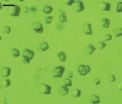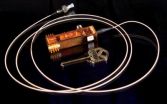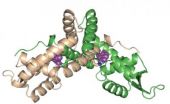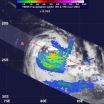(Press-News.org) From providing living cells with energy, to nitrogen fixation, to the splitting of water molecules, the catalytic activities of metalloenzymes – proteins that contain a metal ion – are vital to life on Earth. A better understanding of the chemistry behind these catalytic activities could pave the way for exciting new technologies, most prominently artificial photosynthesis systems that would provide clean, green and renewable energy. Now, researchers with the U.S. Department of Energy (DOE)'s Lawrence Berkeley National Laboratory (Berkeley Lab) and the SLAC National Accelerator Laboratory have taken a major step towards achieving this goal.
Using ultrafast, intensely bright pulses of X-rays from SLAC's Linac Coherent Light Source (LCLS), the world's most powerful X-ray laser, the researchers were able to simultaneously image at room temperature the atomic and electronic structures of photosystem II, a metalloenzyme critical to photosynthesis.
"This is the first time that femtosecond X-ray pulses have been used for the simultaneous collection of both X-ray diffraction (XRD) and X-ray emission spectroscopy (XES) at room temperature of a metalloenzyme crystal," says Junko Yano, a chemist with Berkeley Lab's Physical Biosciences Division who was one of the leaders of this research. "Collecting both diffraction and spectroscopy data from the same crystal under the same conditions is required for a detailed understanding of the mechanisms behind metalloenzyme catalysis."
Yano is a corresponding author, along with Vittal Yachandra, also a chemist with Berkeley Lab's Physical Biosciences Division, and Uwe Bergmann, a physicist with SLAC, of a paper about this research in the journal Science. The paper is titled "Simultaneous Femtosecond X-ray Spectroscopy and Diffraction of
Photosystem II at Room Temperature." (See below for full list of co-authors.)
Photosystem II, a large protein complex in green plants, algae and cyanobacteria, is the only known biological system able to harness sunlight for the oxidation of water into molecular oxygen. Photooxidation of water by photosystem II is responsible for most of the oxygen in Earth's atmosphere. At the core of photosystem II is a manganese-calcium (Mn4Ca) complex that when energized by solar photons catalyzes a four photon-step cycle of oxidation states (S1-to-S4) that ultimately yield molecular oxygen. Scientists need to observe intact X-ray crystallography of the Mn4Ca ion in action but the molecule is highly sensitive to radiation.
"X-ray damage to metalloenzyme crystals has been a big issue for scientists even when the crystals were imaged at cryogenic temperatures," Yachandra says. "The LCLS is the world's only source of X-rays at this time capable of providing femtosecond pulses at the high intensities that enabled us to image intact photosystem II crystals before they were destroyed by exposure to the X-ray beams."
SLAC's LCLS is an X-ray free electron laser (XFEL) powered by a two-mile-long linear accelerator (or linac) that generates pulses of X-ray light on a femtosecond timescale. These pulses are more than a billion times brighter than those from the most powerful synchrotrons. SLAC is operated by Stanford University on behalf of DOE.
With their simultaneous XRD/XES experiments, Yano, Yachandra and their colleagues were able to observe the geometric structure and follow changes in the electronic structure of the Mn4Ca catalyst as they pumped the photosystem II crystal with visible-light laser pulses to simulate solar photons.
"We were able to unequivocally show that both the photosystem II complex and the Mn4Ca complex remain intact through the first two steps (S1 and S2) of the photooxidation process," says Yachandra.
Says Nicholas Sauter, Berkeley Lab computer scientist and a co-author of the study, "To be able to draw these conclusions, we've developed new software tools and are learning how to process the large amounts of data generated by studies such as this in real time."
For the next phase of this research, the researchers plan to study the final two steps in the photosystem II water-splitting process. Understanding how photosystem II is able to split water molecules into oxygen, electrons and hydrogen ions is crucial to the development of an effective and efficient artificial version of photosynthesis that could produce liquid fuels from nothing more than sunlight, carbon dioxide and water.
"Getting critical snapshots of the final photon steps in the photosystem II machinery would really answer all of the questions we have at the moment about how this system works,"
says Jan Kern, a chemist with Berkeley Lab's Physical Biosciences Division and SLAC who is the first author of the Science paper.
Says Yano, "We're interested in understanding the design principles in natural photosynthesis, which can only be obtained by collecting data from all the states and that will be useful for making artificial light-driven catalysts for water-splitting."
Beyond photosystem II and photosynthesis, the Berkeley Lab/SLAC team has demonstrated that simultaneous XRD and XES studies using ultra-short ultra-bright X-ray pulses can be used for future time-resolved studies of light-driven structural changes within protein and metal cofactors, and of chemical dynamics at the catalytic metal centers of metalloenzymes under functional conditions.
"We expect that this method will be applicable to many metalloenzymes, including those that are known to be very sensitive to X-ray photo-reduction and radiation damage, and over a wide range of time scales, starting with femtoseconds," Yano says.
INFORMATION:
Other authors of the Science paper were Roberto Alonso-Mori, Rosalie Tran, Johan Hattne, Richard Gildea, Nathaniel Echols, Carina Glöckner, Julia Hellmich, Hartawan Laksmono, Raymond Sierra, Benedikt Lassalle-Kaiser, Sergey Koroidov, Alyssa Lampe, Guangye Han,Sheraz Gul, Dörte DiFiore, Despina Milathianaki, Alan Fry, Alan Miahnahri, Donald Schafer, Marc Messerschmidt, Marvin Seibert, Jason Koglin, Dimosthenis Sokaras, Tsu-Chien Weng, Jonas Sellberg, Matthew Latimer, Ralf Grosse-Kunstleve, Petrus Zwart, William White, Pieter Glatzel, Paul Adams, Michael Bogan, Garth Williams, Sébastien Boutet, Johannes Messinger and Athina Zouni.
In addition to Berkeley Lab and SLAC, other institutions participating in this study were the Technical University Berlin in Germany, Umeå and Stockholm Universities in Sweden, and the European Synchrotron Radiation Facility in France.
This work was supported by the DOE's Office of Science, the National Institutes of Health, the German Research Foundation (DFG), the Alexander von Humbolt Foundation, Umea University, the K&A Wallengberg Foundation, and the Swedish Energy Agency.
Lawrence Berkeley National Laboratory addresses the world's most urgent scientific challenges by advancing sustainable energy, protecting human health, creating new materials, and revealing the origin and fate of the universe. Founded in 1931, Berkeley Lab's scientific expertise has been recognized with 13 Nobel prizes. The University of California manages Berkeley Lab for the U.S. Department of Energy's Office of Science. For more, visit www.lbl.gov.
LCLS is supported by DOE's Office of Science. SLAC is a multi-program laboratory exploring frontier questions in photon science, astrophysics, particle physics and accelerator research. Located in Menlo Park, California, SLAC is operated by Stanford University for the U.S. Department of Energy Office of Science. To learn more, please visit www.slac.stanford.edu.
DOE's Office of Science is the single largest supporter of basic research in the physical sciences in the United States, and is working to address some of the most pressing challenges of our time. For more information, please visit the Office of Science website at science.energy.gov.
A dual look at photosystem II using the world's most powerful X-ray laser
Berkeley Lab and SLAC researchers demonstrate room temperature simultaneous diffraction/spectroscopy of metalloenzymes
2013-02-15
ELSE PRESS RELEASES FROM THIS DATE:
Noncoding RNAs offer huge therapeutic and diagnostic potential
2013-02-15
New Rochelle, NY, February 14, 2013—As scientists continue to unravel the complexity of the human genome and to uncover vital elements that play a role in both normal physiology and disease, one particular class of elements called noncoding RNAs is gaining a lot of attention. Guest Editor Tom Cech, PhD and Executive Editor Fintan Steele, PhD explore the enormous potential value of this rapidly advancing research area in their Editorial " The (Noncoding) RNA World." The authors introduce a special research section on noncoding RNAs published in the current issue of Nucleic ...
Building healthy bones takes guts
2013-02-15
EAST LANSING, Mich. — In what could be an early step toward new treatments for people with osteoporosis, scientists at Michigan State University report that a natural probiotic supplement can help male mice produce healthier bones.
Interestingly, the same can't be said for female mice, the researchers report in the Journal of Cellular Physiology.
"We know that inflammation in the gut can cause bone loss, though it's unclear exactly why," said lead author Laura McCabe, a professor in MSU's departments of Physiology and Radiology. "The neat thing we found is that a probiotic ...
New methodology to predict pandemics
2013-02-15
NEW YORK – February 13, 2013 – EcoHealth Alliance, the nonprofit organization that focuses on local conservation and global health issues, announced new research focused on the rapid identification of disease outbreaks in the peer reviewed publication, Journal of the Royal Society Interface. The article, authored by leading scientists in the fields of emerging disease ecology, biomathematics, computational biology and bioinformatics, shows how network theory can be used to identify outbreaks of unidentified diseases. The strategy builds on the wealth of online surveillance ...
Quantum cryptography put to work for electric grid security
2013-02-15
LOS ALAMOS, N.M., Feb. 14, 2013—A Los Alamos National Laboratory quantum cryptography (QC) team has successfully completed the first-ever demonstration of securing control data for electric grids using quantum cryptography.
The demonstration was performed in the electric grid test bed that is part of the Trustworthy Cyber Infrastructure for the Power Grid (TCIPG) project at the University of Illinois Urbana-Champaign (UIUC) that was set up under the Department of Energy's Cyber Security for Energy Delivery Systems program in the Office of Electricity Delivery and Energy ...
A microbial biorefinery provides new insight into how bacteria regulate genes
2013-02-15
PROVIDENCE, R.I. [Brown University] — Microorganisms that can break down plant biomass into the precursors of biodiesel or other commodity chemicals might one day be used to produce alternatives to petroleum. But the potential of this "biorefinery" technology is limited by the fact that most microorganisms cannot break down lignin, a highly stable polymer that makes up as much as a third of plant biomass.
Streptomyces bacteria are among few microorganisms known to degrade and consume lignin. Now a group of researchers at Brown University has unlocked the genetic and molecular ...
NASA's Fermi proves supernova remnants produce cosmic rays
2013-02-15
A new study using observations from NASA's Fermi Gamma-ray Space Telescope reveals the first clear-cut evidence the expanding debris of exploded stars produces some of the fastest-moving matter in the universe. This discovery is a major step toward understanding the origin of cosmic rays, one of Fermi's primary mission goals.
"Scientists have been trying to find the sources of high-energy cosmic rays since their discovery a century ago," said Elizabeth Hays, a member of the research team and Fermi deputy project scientist at NASA's Goddard Space Flight Center in Greenbelt, ...
Researchers discover breakthrough in ovarian cancer
2013-02-15
(Phoenix, AZ Feb. 14, 2014) -- Researchers at The University of Arizona Cancer Center at St. Joseph's Hospital and Medical Center in Phoenix have discovered that many women with low-grade serous carcinoma of the ovary or peritoneum have seen their tumors stabilize or shrink after taking a regular dose of the compound selumetinib.
The findings, published in the Feb. 14 edition of The Lancet Oncology, show that selumetinib targets a mutation in the MAPK pathway for patients with low-grade serous carcinoma, allowing for treatment on previously chemoresistant tumors.
"This ...
NASA satellite sees Cyclone Gino's rainfall shoved southward
2013-02-15
NASA's Tropical Rainfall Measuring Mission satellite known as TRMM measured Cyclone Gino's rainfall from space and saw the bulk of precipitation was south of the center. Gino's rainfall is being pushed away from the center by vertical wind shear.
TRMM flew over Cyclone Gino on Thursday, Feb. 14 at 0806 UTC (3:06 a.m. EST) and measured the rainfall rates occurring throughout the storm. The bulk of the rainfall stretched from south to southeast of the center. The heaviest rain was falling at a rate of 2 inches (50 mm) per hour southeast of the center, and scattered throughout ...
Prevention efforts focused on youth reduce prescription abuse into adulthood
2013-02-15
Middle school students from small towns and rural communities who received any of three community-based prevention programs were less likely to abuse prescription medications in late adolescence and young adulthood. The research, published today in the American Journal of Public Health, was funded by the National Institute on Drug Abuse (NIDA), the National Institute on Alcohol Abuse and Alcoholism, and the National Institute of Mental Health, all components of the National Institutes of Health.
"Prescription medications are beneficial when used as prescribed to treat ...
Research finds promising approaches to prevent Latino childhood obesity
2013-02-15
San Diego, CA, February 15, 2013 – Guided grocery store trips, menu labeling at restaurants, community gardens, and video-game-based exercise programs are among several promising, culturally appropriate ways to prevent obesity among Latino children, according to a new collection of studies from Salud America! The Robert Wood Johnson Foundation Research Network to Prevent Obesity Among Latino Children published in a supplement to the March issue of the American Journal of Preventive Medicine.
Salud America! is a national network of researchers, advocates, and policymakers ...
LAST 30 PRESS RELEASES:
Ants: An untapped resource in the development of antibiotics?
Archaeologists use AI to create prehistoric video game
Mitochondria migrate toward the cell membrane in response to high glucose levels
Tiny viral switch offers hope against drug-resistant bacteria
Most parents aware of early peanut introduction guidelines, but confused about details
HPV vaccine can protect against severe lesions of the vulva and vagina
Virtual care provision and emergency department use among children and youth
Quadrivalent HPV vaccine and high-grade vulvovaginal lesions
Insights into dry eyes gained from stem cell-derived tear glands
Researchers identify 166 human pluripotent stem cell lines available for use in clinical applications
Europa Clipper instrument uniquely observed interstellar comet 3I/ATLAS
UN University Report challenges climate change as sole trigger of Syrian Civil War, exposing governance failures in drought response
Real estate investment trust (REIT) acquisition associated with hospital closure and bankruptcy
New Raman imaging system detects subtle tumor signals
Boston Children’s receives a $7.5 million grant from Aligning Research to Impact Autism (ARIA) to provide clinical research coordination for the IMPACT Network
Spray-on antibacterial coating offers new protection for plants against disease and drought
ESMT Berlin study: What makes a first offer successful in negotiations
Groundbreaking ceremony marks the beginning of CTAO-South Array construction in Chile
Why swearing makes you stronger
What prevents more cancer patients from enrolling in potentially life-saving clinical trials?
UK’s worst-case climate risks laid bare for lawmakers
A decline in churchgoing linked to more deaths of despair
TAMEST announces Maralice Conacci-Sorrell, Ph.D., UT Southwestern Medical Center, as 2026 Mary Beth Maddox Award & Lectureship Recipient
Global study to evaluate whether dengue outbreaks can be anticipated earlier
Chonnam National University researchers propose innovative voltage-loop control for power factor correction
Accelerating next-generation drug discovery with click-based construction of PROTACs
Detecting the hidden magnetism of altermagnets
$7M gift supports health research, engineering and athletics at UT San Antonio
NU-9 halts Alzheimer’s disease in animal model before symptoms begin
Hospitals acquired by real estate investment trusts associated with greater risk of bankruptcy, closure
[Press-News.org] A dual look at photosystem II using the world's most powerful X-ray laserBerkeley Lab and SLAC researchers demonstrate room temperature simultaneous diffraction/spectroscopy of metalloenzymes





